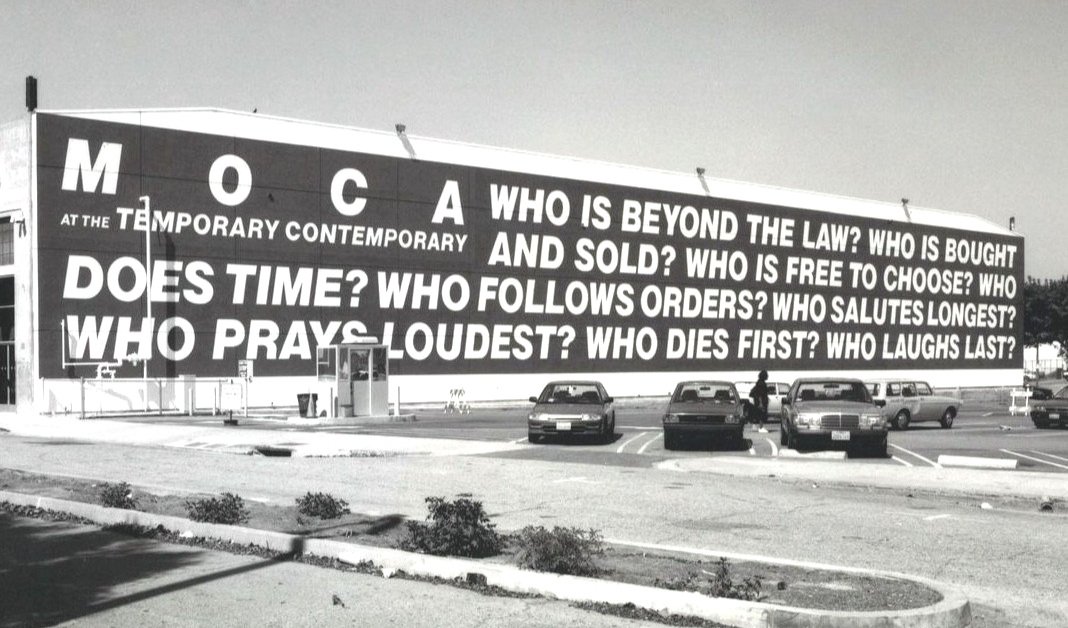This Is Text-Based Art: Barbara Kruger And Words That Mark A Matter Of Public Interest
* * *
This Article Is a Quick Intro To What I Call Word Markers:
This is a neat topic. Three main points for purposes of this intro article: One, as the spectacular text-based artist Barbara Kruger says in some of her interviews, she’s interested in introducing doubt through her particular word and phrase choices. Not saying what to think, not saying her view, just creating doubt. Two, often the best way to both raise doubt and also indicate / mark that “doubt-ish” words are coming is to use interrogatory-ish phrases or words like “should.” (More on such words below, let’s just call them “should” words for now.) Three, to me it’s interesting that these “should” words have a double duty in two very different realms that can be very far apart — the world of art / text-based art / social justice art / political part (small “p”), on the one hand — and the world of protected free speech under the US Constitution / First Amendment, on the other hand. OK, with these three points as foundation, let’s see what Barbara Kruger does in the art context and see it’s application in the free speech context —
Here’s a List of the Basic Word Markers — Law-Style.
Some are more conducive to text art than others; some are more conducive to legal analysis than other. Note that most ultimately incorporate the so-called “reporter’s questions” or “detective’s questions”:
Whether X or Y or Z should or should not happen;
How X or Y or Z should or should not happen;
What should or should not happen;
What should be allowed or permitted, or not allowed or permitted;
Who should or should not do something, be allowed to do something, etc.
Who ought to do something, or not do something;
Who should be held accountable, or not accountable;
Where should something be done or not done;
Why should something be done or not done.
And similar variations.
Compare How They Appear Now — Text Art Style.
In the law, the above language can become overly complicated. In art, particularly with Kruger’s skill, the same language gets right to it. Here are some of Kruger’s most relevant text lines (questions) on this point. The capitalized text is Kruger’s from a recent work:
WHO IS BOUGHT AND SOLD?
WHO IS BEYOND THE LAW?
WHO IS FREE TO CHOOSE?
WHO FOLLOWS ORDERS?
WHO SALUTES LONGEST?
WHO PRAYS LOUDEST?
WHO DIES FIRST?
WHO LAUGHS LAST?
WHO DOES TIME?
Word Markers In Text and Law Relevant To Public Debate
While Kruger works exclusively with “who” in her questions listed here, conceptually they imply the same language found in the law in the public debate of a public matter context. Consider a few examples as re-framed:
Who (what) is (should be) bought and sold?
Who is (should be) above the law?
Word Markers In Their Own Right: Public Discourse
What’s the bottom line? Why does any of this matter? One reason for now (there will be more articles on this) is that not just by her content, but also by her initial marker / signal words themselves, Barbara Kruger is (1) joining public discourse (2) elevating public discourse (3) about matters of public interest meaning (4) matters that involve something more than just the personal (like your own opinion or your own private back yard).
Should As One Of The Most Important Free Speech Words
Loosely speaking, for example, under California law, and likely the laws of other jurisdictions, Kruger’s predicate words, not just her substantive words, establish that her art is focused on public matters; they signal and further the public debate about those matters; and they affirmatively contribute to the public discussion of those matters — just by raising the questions themselves, even in vague ways. “Should.” I realize this may seem either boring or self-evident to some, but the more I ponder it and tinker with it, I think this one word and its broader concept is super cool.
Follow The Modal Verbs In Text-Based Art, Not The Nouns
Sometimes in text-based art the focus is on the noun or the common verb at the expense of the other language. This brief article hopes to have established that equally important in text-based art are the well-placed and well-thought-out pronoun, adverb, and modal verb, such as should. (I had to look that up. It’s a modal verb, who knew?)
Barbara Kruger demonstrates all of this seamlessly and eloquently. If you have any doubt, just compare her questions above (in capital letters) to the cumbersome bullet point language above that I tried to fumble you through.
— Adam Daley Wilson
[About the author: Adam Daley Wilson is a gallery-represented text-based artist. He has traditional academic degrees — a J.D. from Stanford Law School in California and a B.A. from the University of Pennsylvania in Philadelphia. Both include work in comparative studies; the B.A. includes world history.]
[first draft August 2022, revisions October 2022, pending final version]

